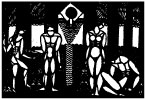The 1917-1918 season had an unplanned surprise seventh bonus bill of new plays that opened on April 26 and ran for seven performances. The first play on the bill was The Hermit and His Messiah, the playbill listing the playwright as F. B. Kugelman, and Flossette Florence Heaton as scenic designer. Not only is there no extant copy of the play, but extensive research turns up nothing on either the author or designer and, with the unusual nature of their names, causes this researcher to believe that these names are likely pseudonyms.(1) When one realizes that this play depicted Jesus, God and the Holy Spirit in art on stage, as well as depicting one of the characters standing in a position as if he’s Christ on the cross, the idea of pseudonyms is even more plausible, since the laws of the state of New York prohibited the portrayal of God on stage. In a letter to Sarlos, Sam Eliot, Jr., one of the play’s two actors, gives his recollection that the play:
Was laid in a cave in the Carpathians inhabited by a crazy anchorite(2) who would draw upon its walls a beardless face and say Son, then add a beard and say Father, then halo and say Holy Ghost. My part was a Russian soldier in flight from Austrians or Germans who stumbles on the cave, finds that the Hermit knows or cares about nothing but mysticism, assumes a crucified position against the wall, plays on the Hermit’s mania and enthusiasm, and gets him to (I think) exchange some outer garments with him and run into the pursuers’ fatal shots while the Russian, as a harmless hermit, settles down to await a better chance to escape.(3)
Heywood Broun describes the plot in his review as “a wounded Russian who induces an Austrian hermit to sacrifice his life for him by making him believe that he is the Redeemer come again.”(4) Sarlos’s description of the play tells that the Russian is a spy, which is why he’s being pursued, and he quickly comes up with a plan when the Hermit will not hide him. The Spy declares to the Hermit that he is the Messiah, proving the matter by bloodying his palms and standing against the cave wall as if he were being crucified. He gets the Hermit to trade enough clothing with him that when the German soldiers come to the cave, they shoot the Hermit, believing him to be the Spy. The play ends as the Russian then takes the Hermit’s place in the cave. Cook played the Hermit and Eliot the Spy. The playbill says it was produced by the actors. The Hermit and His Messiah possessed great possibilities for controversy, not only as a commentary on the war, but as a display of potentially illegal religious imagery; however, no controversy is recorded to have taken place. The work has a certain resonance with some of the Medieval Miracle plays that portrayed hermits waiting for the return of the Messiah, and with La Pastorela, a Mexican version of these plays typically celebrated at Christmastime. One might even see the play as a modern twist on the miracle play, parodying it by combining it with a war theme. Broun thought the play was “interesting but not altogether convincing,” and commented that the playwright’s irony was “laid on too thick” He also states that the play suffers from “insufficient elaboration or better inventiveness,” and that “even a hermit would require a certain amount of convincing; just one little miracle, let us say, or something like that.”(5) The performances aren’t mentioned.
© Jeff Kennedy 2007
(1) Sarlos cites the Yale special collection for a copy of the play, but when contacted, they report that none exists. Kugelman is the same last name as Marx’s trusted friend and mentor, Louis Kugelman, and one wonders if this might have been its reason for being chosen. The set designer’s name stretches credibility with its florid and dramatic construction, particularly as the name of a designer for a set that depicts the inside of a cave.
(2) An anchorite is a person who has retired into seclusion for religious reasons.
(3) Sarlos, Provincetown 190.
(4) Heywood Broun, New York Tribune, 29 April 1918, col 4: 9
(5) Heywood Broun, New York Tribune, 29 April 1918, col 4: 9
